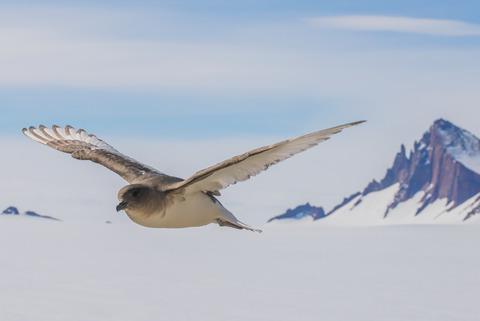当前位置:
X-MOL 学术
›
Funct. Ecol.
›
论文详情
Our official English website, www.x-mol.net, welcomes your
feedback! (Note: you will need to create a separate account there.)
Foraging tactics in dynamic sea‐ice habitats affect individual state in a long‐ranging seabird
Functional Ecology ( IF 4.6 ) Pub Date : 2020-08-03 , DOI: 10.1111/1365-2435.13632 Arnaud Tarroux 1, 2 , Yves Cherel 3 , Per Fauchald 1 , Akiko Kato 3 , Oliver P. Love 4 , Yan Ropert‐Coudert 3 , Gunnar Spreen 2, 5 , Øystein Varpe 6 , Henri Weimerskirch 3 , Nigel G. Yoccoz 7 , Sandrine Zahn 8 , Sébastien Descamps 2
中文翻译:

动态海冰栖息地中的觅食策略会影响远距离海鸟的个体状态
更新日期:2020-08-03
Functional Ecology ( IF 4.6 ) Pub Date : 2020-08-03 , DOI: 10.1111/1365-2435.13632 Arnaud Tarroux 1, 2 , Yves Cherel 3 , Per Fauchald 1 , Akiko Kato 3 , Oliver P. Love 4 , Yan Ropert‐Coudert 3 , Gunnar Spreen 2, 5 , Øystein Varpe 6 , Henri Weimerskirch 3 , Nigel G. Yoccoz 7 , Sandrine Zahn 8 , Sébastien Descamps 2
Affiliation

|
- Individual heterogeneity in diet and foraging behaviour is common in wild animal populations, and can be a strong determinant of how populations respond to environmental changes. Within populations, variation in foraging behaviour and the occurrence of individual tactics in relation to resources distribution can help explain differences in individual fitness, and ultimately identify important factors affecting population dynamics. We examined how foraging behaviour and habitat during the breeding period related to the physiological state of a long‐ranging seabird adapted to sea ice, the Antarctic petrel Thalassoica antarctica.
- Firstly, using GPS tracking and state‐switching movement modelling (hidden Markov models) on 124 individual birds, we tested for the occurrence of distinct foraging tactics within our study population. Our results highlight a large variation in the movement and foraging behaviour of a very mobile seabird, and delineate distinct foraging tactics along a gradient from foraging in dense pack ice to foraging in open water.
- Secondly, we investigated the effects of these foraging tactics on individual state at return from a foraging trip. We combined movement data with morphometric and physiological measurements of a suite of plasma metabolites that provided a general picture of a bird's individual state. Foraging in denser sea ice was associated with lower gain in body mass during brooding, as well as lower level of energy acquisition (plasma triacylglycerol) during both brooding and incubation. We found no clear relationship between the foraging tactic in relation to sea ice and the energetic stress (changes in plasma corticosterone), energetic balance (β‐hydroxybutyrate) or trophic level (δ15N). However, a shorter foraging range was related to both the energetic balance (positively) and the trophic level (negatively).
- Our results highlight a diverse range of foraging tactics in relation to sea ice in Antarctic petrels. While the various foraging tactics do not seem to strongly alter energetic balance, they may affect other aspects of Antarctic petrels' physiology. Future changes in sea‐ice habitats can thus be expected to have an impact on the individual state of seabirds such as Antarctic petrels, which could ultimately affect their population dynamics. Nonetheless, strong individual heterogeneity in the use of sea‐ice habitats by a typical pagophilic species might strengthen its resilience to environmental changes and in particular to forecasted sea‐ice loss.
中文翻译:

动态海冰栖息地中的觅食策略会影响远距离海鸟的个体状态
- 饮食和觅食行为的个体异质性在野生动物种群中很常见,并且可以强烈决定种群对环境变化的反应方式。在种群内部,觅食行为的变化和与资源分配有关的个体策略的出现可以帮助解释个体适应度的差异,并最终确定影响种群动态的重要因素。我们研究了繁殖期的觅食行为和栖息地如何与适应海冰的长距离海鸟(南极海燕南极海藻)的生理状态相关。
- 首先,我们使用GPS跟踪和状态转换运动模型(隐马尔可夫模型)对124只个体鸟类进行了测试,测试了研究种群中不同觅食策略的发生。我们的研究结果突显了非常易移动的海鸟在运动和觅食行为上的巨大差异,并描绘了从浓密冰块觅食到开阔水域觅食的不同梯度的觅食策略。
- 其次,我们调查了觅食旅行返回时这些觅食策略对个体状态的影响。我们将运动数据与一组血浆代谢物的形态测量和生理测量结果结合在一起,从而提供了鸟类个体状态的大致信息。在较深的海冰中觅食与在育雏期间体重增加较低以及在育雏和孵化期间较低的能量获取水平(血浆三酰基甘油)有关。我们发现相对于海冰和充满活力的应力(在血浆皮质酮的变化),能量平衡(β羟基丁酸酯)或营养级(δ觅食策略之间没有明显的关系,15 N)。然而,较短的觅食范围与能量平衡(正)和营养级(负)有关。
- 我们的结果突出了与南极海燕海冰有关的多种觅食策略。尽管各种觅食策略似乎并没有强烈改变能量平衡,但是它们可能会影响南极海燕生理的其他方面。因此,预计海冰生境的未来变化将对诸如南极海燕之类的海鸟的个体状况产生影响,最终可能影响其种群动态。但是,典型的嗜食性物种在使用海冰栖息地时强烈的个体异质性可能会增强其对环境变化的抵御能力,尤其是对预测的海冰损失的抵御能力。











































 京公网安备 11010802027423号
京公网安备 11010802027423号